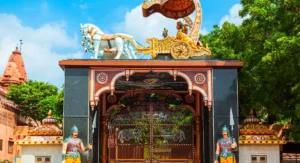When you attempt to touch the layered fabric of Mathura History, you soon realize that you are not merely entering into the account of a city, but into a living archive where myth and memory, art and devotion, politics and poetry have remained interwoven for centuries. There was a time when messages from this land traveled only through scriptures, carvings, and stories whispered by wandering saints, but today, as you and I look back, the same stories come alive through museums, temples, and the very breath of the Yamuna that continues to flow.
Table of Contents
ToggleWhat Do We Find in the Ancient History of Mathura City?
If you go deeper into the ancient history of Mathura city, you discover that even before mighty dynasties carved their emblems, this place had already established itself as a seat of culture and commerce. Terracotta figurines, coins buried beneath layers of dust, and inscriptions chiselled on stone remind us that Mathura was not an accidental settlement, but a carefully nurtured center of life and art. The Kushan rulers did not merely govern here; they offered Mathura to the world as a workshop of sculpture, creating images that still tell us how elegance and spirituality can walk together.
And yet, do you not wonder how a single city became a shelter for Buddhists, Jains, and Hindus at the same time? Every faith sought space here, every traveller carried away something of Mathura, and in return left behind another strand of memory.
How is Mathura and Lord Krishna Connection Preserved?
But let us admit—no description of Mathura can ever escape the Mathura and Lord Krishna connection. It was in the dimly lit prison chamber of Kamsa’s tyranny that a divine child was born, and that single birth turned the city into an immortal stage of devotion. When you walk through Mathura today, you do not merely see markets and temples; you sense the laughter of the child Krishna, the daring of the youth who fought injustice, and the eternal guide whose words of dharma still echo in our ears.
If letters once carried Gandhi’s voice across continents, it is the chants of Krishna in Mathura that carry a timeless reassurance to countless pilgrims even now.
What Is the Historical Significance of Mathura Temples?
The historical significance of Mathura temples does not lie in stone alone, for stone can be broken and rebuilt. It lies in the persistence of faith that refuses to die. These temples have fallen to invasions, they have risen again through the devotion of ordinary people, and each reconstruction has added another layer to the city’s history. The shrines stand not as silent walls but as speaking witnesses, telling you and me how resilience can be more powerful than destruction.
And can one ignore that every dome, every carved pillar, every idol placed inside carries not only devotion but also the craftsmanship of artisans who, centuries ago, believed that beauty itself is a form of worship?
Why Does Mathura Still Mirror India’s Cultural Soul?
To speak of Mathura is to speak of India itself. Where else do you find such a seamless blending—ancient art and present-day rituals, mythological memory and historical evidence, trade routes of yesterday and pilgrimage roads of today? You may carry a mobile phone now instead of a palm-leaf manuscript, yet the act of sending home a story after visiting Mathura is no less sacred.
If Nehru once chose letters to inspire Indira, Mathura chooses its temples, its ghats, its festivals to inspire generations of Indians. And perhaps you too will agree, that the city is less a place and more a mirror in which India keeps seeing its own reflection.
Mathura Vrindavan Temples – Keeping the Flame Alive
Our brand, Mathura Vrindavan Temples, carries forward the responsibility of not letting this flame diminish. For when you visit, you do not merely step into a monument, you step into centuries of prayer and memory, into a continuum where the ancient past still speaks to the modern heart.
FAQs of the Mathura History
Q1. Why is Mathura History so important?
Because it blends archaeology, mythology, and spirituality, making it one of the oldest living cultural landscapes of India.
Q2. What makes the ancient history of Mathura city unique?
Its archaeological remains, terracotta art, coins, and inscriptions show Mathura as a thriving hub long before great dynasties rose.
Q3. Why is Mathura and Lord Krishna connection inseparable?
Because Krishna’s birth in Mathura transformed the city into an eternal center of devotion, remembered and celebrated across the world.
Q4. What is the historical significance of Mathura temples?
They represent resilience; repeatedly destroyed and rebuilt, these temples symbolize the strength of faith and the artistry of generations.
Q5. Why should modern travelers explore Mathura?
To experience living heritage—where ancient temples, vibrant rituals, and the enduring stories of Krishna make history a present reality.
Plan Your Spiritual Journey Today
Have questions or need assistance organizing your visit to the sacred temples of Mathura and Vrindavan? We’re here to help you every step of the way.
Email us at info@mathuravrindavantemples.com
Call or WhatsApp us at +91-7819818361
Let the divine journey begin with Mathura Vrindavan Temples.




